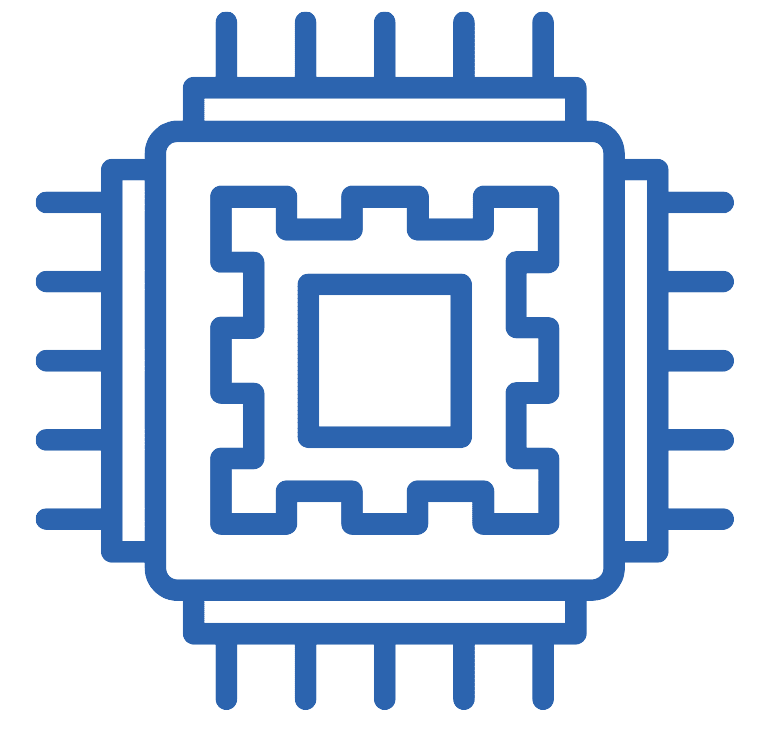
Programming Subsystems Used In The Creation of Semiconductor Chips
E Tech Group programmed integral subsystems for a tin droplet delivery mechanism in a piece of machinery that creates components the world’s most sophisticated pieces of technology are dependent upon.
Project
E Tech Group was contacted by a company in the Netherlands that works in the production of machinery necessary in the production of semiconductor chips.
The process to create these ever-smaller transistors and print them on a chip is incredibly complex. The machine created for this process is the size of a city bus and can cost upwards of three hundred and fifty million dollars. The machine is used in a process called Extreme Ultraviolet Lithography (EUV), all starting with microscopic tin droplets needing to be shot across a vacuum chamber in a stream controlled by piezoelectric to get them precisely aligned for the next critical phase of the process.
E Tech Group was brought on in April of 2022 to handle the programming of several of the machine’s critical sub-systems, relating for the most part to the droplet delivery mechanism, which itself was comprised of eight other subsystems working precisely in tune with each other.
A large part of the machine’s programming would be based off of an earlier system, called a TRQT. The TRQT software was to act as a jumping-off point for the E Tech Group team to replicate but would also need to keep the TRQT software intact, as there were some intricacies in its code that would take too long to untangle and rewrite.
The software for another piece planned to coexist in this process, the HPQT, was all written from scratch and would have to interface with some of the existing TRQT code. When the team first started working on the TRQT and HPQT collaboration, they were quite overwhelmed at how much they didn’t understand about the process. Luckily, with the help of ASML’s chief design engineer, they were able to integrate the two software halves into one functional piece of code.
Another entity would program the portion of the project that was done in TIA Portal, however, the HMI portion had to be done in Labview. Not being familiar with Labview, the other group utilized the diverse skillset of a few other engineers from across the E Tech Group organization to help execute initially. However, due to unforeseen circumstances, the decision was made to have the team hand off the remaining Labview work to one of the subcontractors who continued the graphical programming alongside the portions of the project E Tech Group was tackling.
Challenges
The HMI programmers required help with understanding and installing the TIA portal program. They required instruction on how to use the simulation software to create their own environment where they were able to test their Labview connectivity and graphics. Having made a few screen records and scheduled a few classes to teach them at first created a bit of a slowdown. Once they caught on, they were able to increase efficiency since there was no longer a need for preliminary testing.
The project also required massive amounts of tedious data entry that had the potential to remain dynamic throughout the process development. This data was what the subsystems would use to decide which heaters should be on in this step, what valves would be open in this other step, or to what atmosphere we would need to pressurize an accumulator to. This data was collected in Excel tables but needed to be migrated into user-defined data types in the TIA portal. In the beginning, this was hand-entered and could take up to two days to complete since TIA doesn’t support natively support excel imports for UDTs. To speed up this process, the E Tech Group team created a program in Python that successfully sped up the data entry exponentially after a few experimental tests.
One of the largest challenges is that all of this was done remotely. Each of the team members were located in different areas of the country, and one was working abroad for a few months.
Once parts were defined, designed, and started arriving at the testing facility in Saugerties, NY, the lead engineer on the project would be on site to oversee assembly and for FAT (Factory Acceptance Testing). However, for the majority of the project, worked remotely.
Results
E Tech Group and the client are currently in the end stages of the FAT (Factory Acceptance Testing). When finalized, the completed portion of the larger machine will be shipped to San Diego and assembled with the remaining pieces, finishing the final product. Which, when operational, will indeed be the size of a city bus and carry that hefty price tag of three hundred and fifty million dollars.
While this project fell outside of the traditional scope of expertise many of the engineers carried when entering the project, completing it has allowed our team to challenge themselves and rise to the occasion, deepening their process development and deployment expertise in a rapidly growing market.
Contact Us
"*" indicates required fields